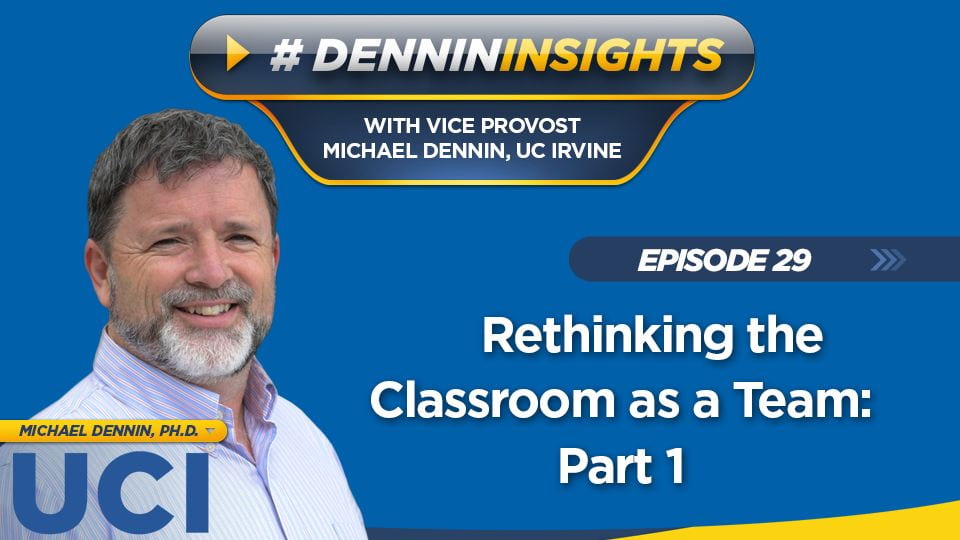
On April 20, 2022, I hosted a special panel that brought together a group of UCI coaches, art directors, and dance faculty to discuss different approaches to teaching a class. This panel generated a number of surprise thoughts, and I decided to dive in and explore these different ideas in a series of blog posts. For full context, please watch the panel recording here.
The first comment that resonated with the group was the statement: “Coaches get to pick their players, but instructors generally do not.” However, as the discussion continued, we noted that the situation is more nuanced than this statement indicates. Coaches are often in situations where they do not get to pick every player on their team, and while instructors do not get to select each individual student in their class, the students accepted to the university are very much hand-picked to be there. All this is to say that sometimes coaches do not have full control over the athletes they coach, and while instructors cannot pick the individual students they teach, every student who ends up in their classes does meet a high level of standards.
As so often happens, as I was planning this particular blog, Chancellor Gillman made a set of related remarks that succinctly encapsulates the main points I was hoping to make in this post! To summarize, Chancellor Gillman compared the traditional approach to college success that says “look to your left, look to your right—only one of you will still be here” to a more inclusive approach that looks to support all students in their success. His analogy compared a “Navy Seal washout” model and the military “leave no one behind’ model to drive home the fact that at UCI (and many other universities), students have already met a common high-level of standards that allowed them entry. Given this, we do not need to go through a process of “washing them out.” Instead, we need to adopt the attitude that we are all in this together and that we do not leave someone behind, even when they stumble. Our approach should be to provide the tools and environment for all students to succeed rather than filtering for a select few and empowering only their success.
If we think about the classic perspective on introductory courses that view these courses as a way to weed out “unqualified students,” its analogous activity in sports would be recruitment and tryouts where coaches determine the best athletes and select their teams. To use Chancellor Gillman’s terms, adopting this perspective would mean treating the first year at university as the “washout” year. So, what’s the better alternative?
If we continue our analogy with sports, there is a stage between making a team and being on a team that we might call “training camp.” Even after being recruited and deemed qualified, there is an ongoing process where athletes and coaches work together to evaluate the player’s place on the team. Some will decide to stay, and others may decide to pursue other opportunities. The players that stay will work to determine their role and place on the team—position, starting player or support player, etc. In some cases, surprise walk-on athletes may suddenly join the team, their passion and effort evident once they arrive. While this stage is characterized by exploration of place and passion, the coaches continue to offer support and training for all the athletes throughout the process.
Why do I highlight this? It suggests a better way to think about the first year of university as a year of exploration. If we equate admission to the university to tryouts, we can reframe the first year as equivalent to ”training camp.” Just like the coaches who continue to offer support to the athletes even as they come and go, instructors can provide students with a range of experiences that help them maximize their ability and discover where their passions lie. In this way, instructors can think of each major as a different “team” that is participating in the training camp. Yes, we will still have motion in and out of our majors, but it will be driven more by the students than barriers that are potentially too narrow and causing us to lose talent!
It can seem to have little impact, but our attitude and view of the first year for students really matters. This is something that the coaches and arts faculty made clear to me. Our approach toward students can determine whether we are empowering successful outcomes or unintentionally limiting them. At this point in our history, we know the students admitted to UCI are all top students. We also know that they come with a range of strengths, weaknesses, training, and experiences, and if we are not creative and flexible enough to leverage this diversity, we will create “teams” of lower quality!
As I have stated before, this is not necessarily because what we have been doing is “wrong” or “broken”— it is because this system was designed for a different set of students and a different set of goals. It succeeded in allowing a subset of students that already had a particular set of strengths to become academics and professionals in fields that require those strengths. But our circumstances and goals have changed, and we now recognize that every student’s path to success is different and that the workforce demands greater diversity. To quote Chancellor Gillman again, “Our students are good enough that it is time to consider implementing a standard of no one gets left behind!”
Recent Comments